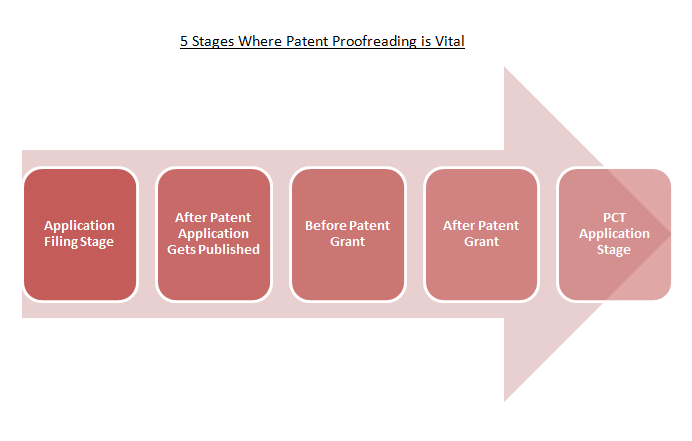5 Stages Where Patent Proofreading Services Are Critical
Drafting an impeccable patent application is vital for a successful patent grant. A spotless application spares applicants of unnecessary office actions and provides the protection their innovation deserves. However, to err is human, and patent proofreading is a protective mechanism to weed out mistakes that can result in restriction and/or rejection of the patent application.
Table of Contents
So what is Patent Proofreading?
Patent proofreading is a process to identify and correct unnoticed inconsistencies that creep in during the meticulous patent drafting process. From ensuring that illustrations, captions and labels correspond with each other to checking claims for enablement, a qualified proofreader conforms to standard parameters to assure seamless patent grant.
Why is Patent Proofreading Needed?
Interestingly, a survey conducted on a sample of around 1,600 patents – issued by USPTO – had revealed that nearly 98% contained mistakes and at least 2% had errors grave enough to ruin the original claim. This just reiterates the need for patent proofreading even more.
Major Errors in a Patent Application
Considering the time and money one invests in drafting a patent, proofreading is an indispensable step in ensuring error-free patent specifications. Here are the few areas where errors are most common:
- Errors in Defining Scope of Patent
If a patent is too broad, it runs the risk of rejection. On the contrary, a narrow patent scope renders it useless. It’s crucial to strike a balance because mistakes limit the scope of disclosure. Patent proofreading ensures that the draft rightly specifies the boundaries of protection sought by an applicant.
- Errors in Defining Scope of Claim
Claim construction is a key part of patent specification. Ambiguous or incorrect defining of claim elements can depict disharmony between the disclosure and the claim, affecting the enforceability of a patent. Proofreading helps in identifying missing claims and ambiguous antecedent references. It gives the claim a definite structure. A well-drafted and articulate claim mitigates the risk of patent rejection.
- Grammatical Error
Though grammar may seem like an insignificant element, it can lead to invalidation of a patent claim in extreme cases. Simple spelling mistakes and inconsistencies can impact the idea that a sentence conveys, altering its meaning. Proofreading ensures that sentences are unequivocal and concise to convey the desired meaning.
- Errors in Enabling Invention
Sometimes, a patent application may miss out on disclosing the enabling invention, ultimately leading to its rejection. Patent proofreading helps in reviewing the disclosure of enabling invention. A qualified proofreader will ensure that such errors are taken care of at the very beginning of the patent.
- Errors in Defining Constituents of the Drawings Invention
If an element of the drawing is not explicitly disclosed in the patent specification, it might attract a restriction from the office action. Proof Reading therefore ensures that all the elements mentioned within the drawing are explicitly defined in the specifications.
5 Stages Where Patent Proofreading is Vital
Patent drafting is characterized by extensive exchange of information, which makes it prone to mistakes at several stages. In this regard, the above-mentioned survey, conducted on samples of 1,600 US patents, also highlights that 50% of the mistakes in the patent draft were made by the USPTO during the prosecution stage and the other half were made by applicants.
To prevent such errors, patent proofreading can be done at multiple stages. Therefore, consider proofreading the patent during these five critical scenarios:

1. Application Filing Stage
Application filing is a stage at which the innovator or applicant plans to file for a patent by drafting an application. It is at this point where the majority of grammatical errors and incorrect claim dependencies occur. IP firms start proofreading at this stage by obtaining a word copy of the application from the client. They ensure that the application meets the required parameters. Proofreading at this point also reduces the possibility of objection being raised under U.S.C 102 or 103 – for not following USPTO norms.
2. After Patent Application Gets Published
Suppose the application is published in the US without objections and the client seeks to expand it beyond the native country. In such a case, it would be imperative to consider the application parameters of the country of interest. Proofreading at this stage ensures that the amendments (even preliminary), filed by the applicants during publication are incorporated. Therefore, when an application is extended to different countries in future, there is a lesser possibility of rejection.
3. Before Patent Grant
Once a patent is granted, it costs nearly $150 for correcting each applicant error. Therefore, proofreading the patent before the grant prevents Certification of Correction(CoC) cost. It should be done just before the patent gets issued, as it is the most optimal use of effort from the proofreader. Proofreading at this stage balances out the cost as well the value of efforts.
4. After Patent Grant
Proofreading under this scenario is to confirm whether everything has been rightly incorporated in the final document. The process is rather simple. The intellectual property professional will download the patent and its image file wrapper and proofread it. Once the patent is granted, it increases the chances of ‘office of action’ by other country examiners. Therefore, proofreading after the patent grant is beneficial for the applicant.
5. PCT Application Stage
Clients often ask their respective IP service providers toproofread the PCT application. After PCT publication, the application enters a different national stage and is prone to rejection from a respective national stage’s country’s examiner. Therefore, the process helps to increase patent proofreading advantages at this stage.
Conclusion
Considering the perils of neglecting patent proofreading, the importance of the process cannot be emphasized enough. Rejection of a patent draft due to specification riddled with errors is the last thing an applicant would aspire for – given the painstaking and cost-intensive process of drafting a patent. Therefore, a simple step such as proofreading ensures the fruition of an innovator’s hard work.
Sagacious IP’s proofreading service offers detailed cross examination of a granted patent. Our highly-skilled patent professionals ensure that your application remains flawless throughout the process of patent grant. Click here to watch the webinar on the subject.
– Prateek Mohunta (COO), Sameer Kumar (IPMS) and the Editorial Team
Having Queries? Contact Us Now!
"*" indicates required fields




